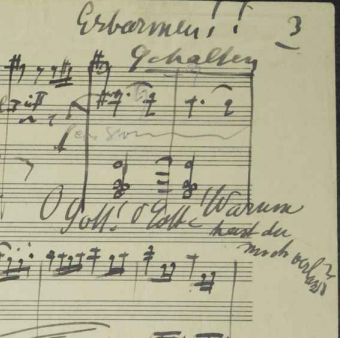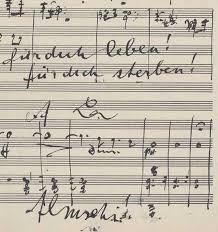Mahler’s Tenth and the Problems with Completions
On May 16 to 18, 2024, conductor Giancarlo Guerrero and the Nashville Symphony produced, under the title Mahler’s Monumental Opus, a performance of the Deryck Cooke completion of Mahler’s 10th Symphony, which Mahler left unfinished at his death (the concert was postponed from April of 2020). For the first half of the concert, we were treated to a lecture by Maestro Guerrero that elaborated on the harmonic and thematic unity of the work, simultaneously introducing the primary themes of the work even as it apologized for Cooke’s completion, a completion that was long ago approved by Mahler’s wife, Alma (née Schindler). He gave a similar lecture on the piece at the very onset of the pandemic in April 2020. The evening represented a wonderful intellectual and aesthetic investigation unique to the world of music.

Simply put, performing a posthumous “completion” can be quite problematic—even one prepared by the eminent musicologist (famous for his catalog of Wagnerian leitmotives) Deryck Cooke. There are a number of completions in various positions within the repertoire and each have their own riddles. For example, Johann Sebastian Bach’s epic Die Kunst der Fuge (The Art of the Fugue) breaks off media res in the 239th measure of Counterpoint XIV, the last (?) fugue. The overall work was written with an ever-increasing sophistication in terms of subject and counterpoint leading a number of scholars (composers and musicologists) to attempt its conclusion, but none are really satisfying. I prefer Glenn Gould’s dramatic flourish and fade to black.
At least these Bach scholars had an overall design and organization (the increasing complexity) to build from. In 1988 Barry Cooper infamously formed an entire movement of what he would call “Beethoven’s Tenth” from 250 measures in sketch. In 2021, a would be modern Frankenstein, sought to employ AI to bring life to the work (“We found a way to feed Beethoven’s ideas into the AI and it advances them.” Yeah, right.)
Interestingly, the exercise (finishing a genius’ work) creates a unique Bloomian “Anxiety of Influence” in that the completer needs to recreate the sound and style of the composer even as they attempt to construct the innovations (the aspects that make the work different from the composer’s previous works) and the extension of the aesthetic process that might have determined the composer’s unfinished remains. No matter how close one was to the composer in life, how knowledgeable one might be of a composer’s intentions, completions can be problematic.
Franz Xaver Süssmayr’s “completion” of Mozart’s Requiem is just one example. Süssmayr was a friend and assistant to Mozart at his death and before as Mozart worked on portions of the Requiem. Indeed, Mozart’s wife Constanze would eventually ask Süssmayr to complete it. Nevertheless, and despite her approval, the work is fraught with challenges, which have been described as Süssmayr’s “transgressions.” Thus, the Requiem has enjoyed a number of competing 20th Century revisions, each of them too, is problematic.
One completion that has had success in entering its composer’s canon was Alban Berg’s Lulu. The first reason for its success is that a large portion of the work was already completed–two of the three acts complete with major sections of the third also orchestrated (and material used in an Orchestral Suite). What wasn’t orchestrated existed in short score with detailed indications of what Berg intended. Importantly, even in its incomplete state, for much of the 20th century the opera was performed and appreciated for the aesthetic development it represents over Berg’s previous masterpiece, Wozzeck. Specifically, Lulu contains a much more extensive use of serialism than Wozzeck, deriving character’s leitmotivs from the collection as Wagner does with melody, and it employs a formal symmetry that is clearly influenced by Webern, his colleague and fellow student of Schoenberg. Finally, as William Kentridge has noted, Lulu is much more of an interiorized opera, seeded in the depths of German expressionism.
All of these characteristics are clearly available in the remaining, unfinished score, and as such, in terms of influence, the completion was not necessary in order to understand the development of Berg’s compositional style, it only allowed for complete performance. As such Berg’s Lulu decidedly expresses more regarding the next developments of Berg’s style (had he lived), than the Requiem, Die Kunst der Fuge, or the Tenth Symphony tell us about Mozart, Bach or Beethoven respectively.

In some ways, Mahler’s Tenth Symphony lies somewhere between Berg’s and the other completions. With only two complete movements (the first and third of five) and the others requiring transcription and orchestration, there is a lot of music missing. However, what remains, especially the first movement, is quite innovative and has been often performed. Specifically, the build up to the colossal dissonance at the height of the first movement is an extension of the “Maximalism” and “Gigantism” that scholars have recognized in his work. The moment was wonderfully demonstrated by Guerrero and the ensemble in his lecture. The third movement, also completed by Mahler before death, is a curiously slight movement titled “Purgatorio” that breaks so far from previous works that one is drawn to biography for answers, indeed by writing “Erbarmen!!” (Mercy!) and citing psalm 21 “O Gott! O Gott! Warum hast du mich verlassen?” (“O God, Why have you forsaken me?”) in the sketches themselves Mahler invites the interpreter to his biography.
However, this is where his work is quite different from Berg’s. Mahler knew his health was deteriorating and death was imminent. In 1907, years before the work, he was diagnosed with a mitral valve defect and related, recurring endocarditis. Further, not only was he concerned with his legacy, he discovered that his wife, Alma, was having an affair with the architect Walter Gropius (a development that led him to Sigmund Freud’s couch, quite literally). Thus, it would seem that the Tenth Symphony partially expresses his torment at this stage of his life.
Above the fourth movement, a violent Scherzo, Mahler wrote “the devil dances it with me!” Cooke placed the primary theme of this movement in a solo trombone marked forte, creating a remarkably grotesque expression played wonderfully by Paul Jenkins in Nashville. Concerning the percussion that ends the movement (as the devil dances away), Guerrero, in his lecture, pointed to a profound connection between Mahler and Stravinsky’s Soldier’s Tale in which the devil is also portrayed in the percussion. One also notes that in Weber’s Der Freischütz the devil is always accompanied by three beats on the drum.


Guerrero’s argument, and he’s not wrong, is that the entire symphony, including Cooke’s completion, should be performed, because of its thematic unity. Mahler brings the primary theme from the first movement back in the finale, creating a unified work and Cooke’s orchestration is stylistically close enough that the expression is viable. Merely hearing the first movement is incomplete, like hearing only the exposition of a sonata from, or the pilot for a whole season of the Game of Thrones. The extended expression is the work, and this, no matter how imperfect, is simply as close as we can get to Mahler’s intentioned expression. However, I believe it is the closing cadence that is much more important.
In his biographies, Mahler’s Ninth Symphony, especially its long ending completed just before the tenth was begun, is typically associated with his death, and the death of his daughter Maria Anna in 1907. This ending is often described as his last statement in life, about life, and it is a sad, marked resignation.
However, the ending of the Tenth, in sketch and in Cooke’s realization, concludes in a moving, peaceful and gracious way, matching the composer’s note to his wife in the sketch: “To live for you! To die for you!” Even at the doorstep of his death, this symphony doesn’t express resignation, it expresses an optimism and joy, and his passion for Alma that reminds the listener that Mahler was only 50 when he was taken from us, and there was much more music that might have been (a point that Guerrero makes clearly). Considered broadly, it makes sense; Just as Beethoven’s symphonies come in pairs of contrasting moods, it is highly possible that Mahler felt joy, love, and gratefulness on the very same days that he felt the fear, anger, and pain of his approaching death–humans have complicated emotions. What makes this completion important is that it both indicates the next aesthetic step taken in Mahler’s musical style but it also enriches our understanding of his musical and personal biography at one of the most difficult periods of his life..
As I left the Schermerhorn, I realized how lucky we are here in Music City. To be able to hear such a work, preceded by a close, nuanced, and interesting investigation of its merits, is simply remarkable for an orchestra in a city of Nashville’s size. Guerrero has lifted Nashville’s Orchestra to great heights and will leave a heavy baton for whoever will replace him in the Fall of 2025—not surprisingly he will end his tenure here next spring with Mahler’s Symphony for a Thousand (the 8th). On a related note, Cooke completed Mahler’s 10th Symphony for a BBC performance and then gave a detailed, illustrated talk in 1964, much the same as Guerrero has done here. Recently (early this month) Maestro Guerrero guest conducted with the BBC National Orchestra of Wales—conjecture abounds. In anycase, we hope the road rises to meet him and, in the meantime, the Nashville Symphony returns May 30-June 2 with Carmina Burana as well as Alban Berg’s Seven Early Songs and Mahler’s Songs of the Wayfarer.



